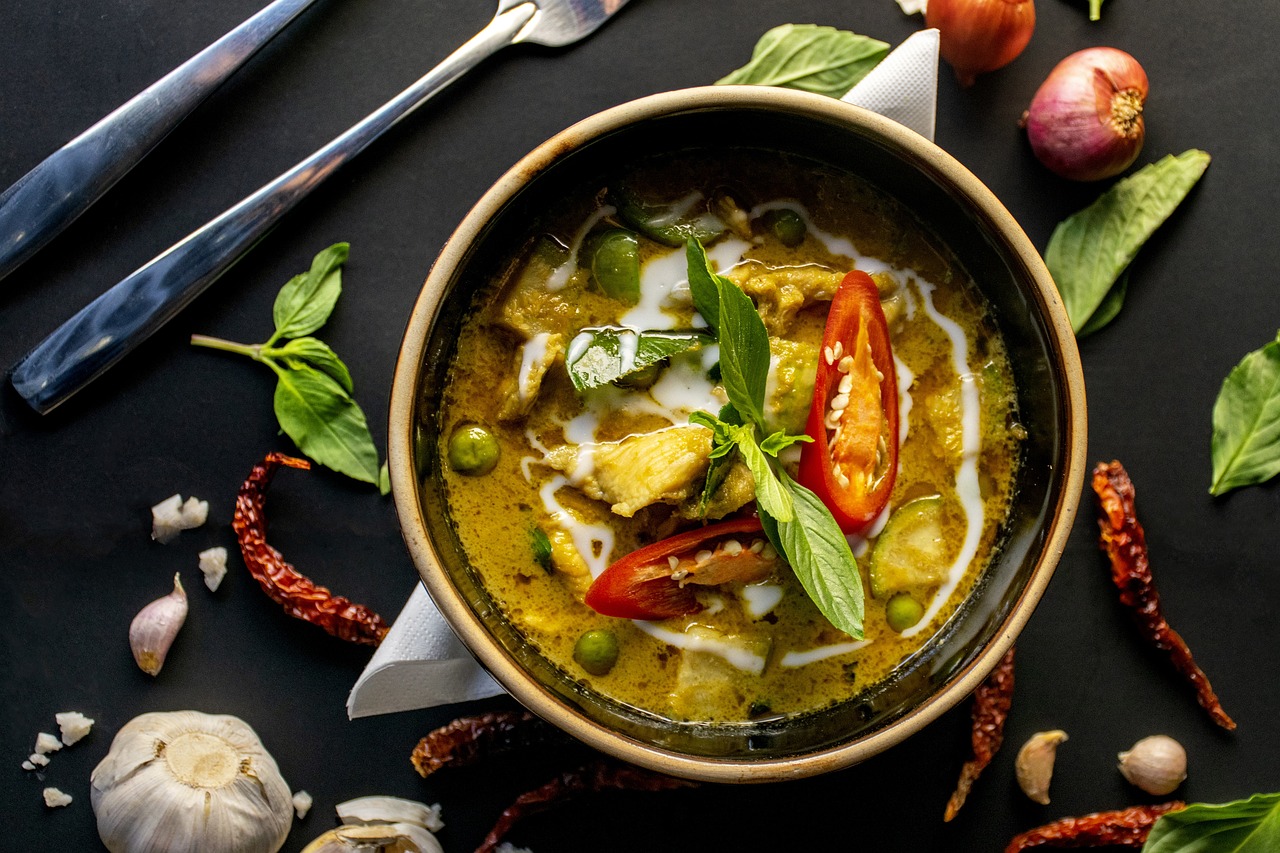If you’ve ever ventured into the world of Thai cuisine, you’ve likely encountered the exquisite array of Thai curries. These mouthwatering dishes are renowned for their complex flavors, aromatic spices, and vibrant colors. Among the
If you’ve ever ventured into the world of Thai cuisine, you’ve likely encountered the exquisite array of Thai curries. These mouthwatering dishes are renowned for their complex flavors, aromatic spices, and vibrant colors. Among the most popular are green, red, yellow, and Massaman curries, each offering a unique taste experience. In this blog, we’re going to demystify these different Thai curry varieties, shedding light on their ingredients, flavors, and regional influences.
-
Green Curry (Kaeng Khiao Wan):
Let’s begin with one of the most iconic Thai curries – the green curry. This curry derives its name from the green color, which comes from the combination of fresh green chili peppers and aromatic herbs like basil, cilantro, and kaffir lime leaves. Coconut milk adds a creamy richness, and the base flavors are typically balanced with fish sauce and palm sugar.
Green curry is known for its vibrant and intense heat, making it a popular choice for spice lovers. It’s often paired with a variety of proteins like chicken, shrimp, or tofu, creating a fragrant, spicy, and slightly sweet dish. In Thailand, green curry is believed to have originated in the central region and is a staple in many Thai households.
-
Red Curry (Kaeng Phet):
Red curry, with its fiery hue, is another Thai curry that’s widely adored. The rich red color comes from red chili peppers, which can vary in spiciness, along with other aromatic spices like lemongrass, ginger, and garlic. Like the green curry, red curry also includes coconut milk, providing a creamy and luscious base. The flavors are typically balanced with fish sauce and palm sugar.
The spiciness level of red curry can be adjusted to suit individual preferences. You’ll find a spectrum of heat, from mild to extremely hot. Common protein choices for red curry include beef, duck, or even vegetables. Red curry hails from the southern region of Thailand and carries the bold, spicy, and tropical flavors of that area.
-
Yellow Curry (Kaeng Kari):
Yellow curry, a milder Thai curry, is appreciated for its delicate blend of flavors. The yellow hue comes from turmeric, which gives the curry its distinct color and mild earthy flavor. Yellow curry paste also contains cumin, coriander, and other spices, creating a harmonious balance.
Compared to green and red curries, yellow curry is generally less spicy. It features proteins like chicken or seafood and is known for its comforting and soothing qualities. Some versions include potatoes, creating a hearty and filling dish. Yellow curry is often enjoyed in central and northern regions of Thailand.

-
Massaman Curry (Kaeng Matsaman):
Massaman curry stands out from the other Thai curry varieties due to its unique blend of Middle Eastern and Thai influences. This curry is rich and hearty, featuring slow-cooked tender beef or chicken, potatoes, peanuts, and a mix of warming spices like cinnamon, cardamom, and cloves.
The name “Massaman” is believed to be derived from “Mussulman” or Muslim, reflecting the historical Islamic influence in southern Thailand. This curry is characterized by its mild, sweet, and nutty flavor, distinct from the spicier Thai curries. Massaman curry has a thicker, more gravy-like consistency, making it an excellent choice for those seeking a hearty and satisfying meal.
-
Panang Curry (Kaeng Phanaeng):
Panang curry is often described as a thicker and richer variation of red curry. It features red curry paste with the addition of crushed peanuts and sometimes coconut cream, resulting in a creamier and slightly sweet flavor profile. Panang curry is typically less soupy than other Thai curries, creating a thick, luxurious sauce that clings to your chosen protein, which can range from chicken to beef to tofu.
The flavors of Panang curry are bold, nutty, and slightly sweet, making it a popular choice for those who appreciate rich and indulgent dishes. It’s often garnished with thinly sliced kaffir lime leaves and red chili for a burst of freshness and color.
In conclusion, Thai curries are a testament to the culinary artistry of Thailand. From the fiery green curry to the aromatic Massaman curry, each variety offers a unique experience, influenced by regional traditions and local ingredients. So the next time you explore Thai cuisine, remember that there’s a Thai curry for every palate, whether you’re a fan of fiery spiciness, rich and creamy flavors, or something in between.
Ready to embark on a culinary journey through the enchanting flavors of Thai cuisine? Visit Mia Thai Cuisine in Montreal today and experience the Thai curry wonders they’ve just uncovered!

